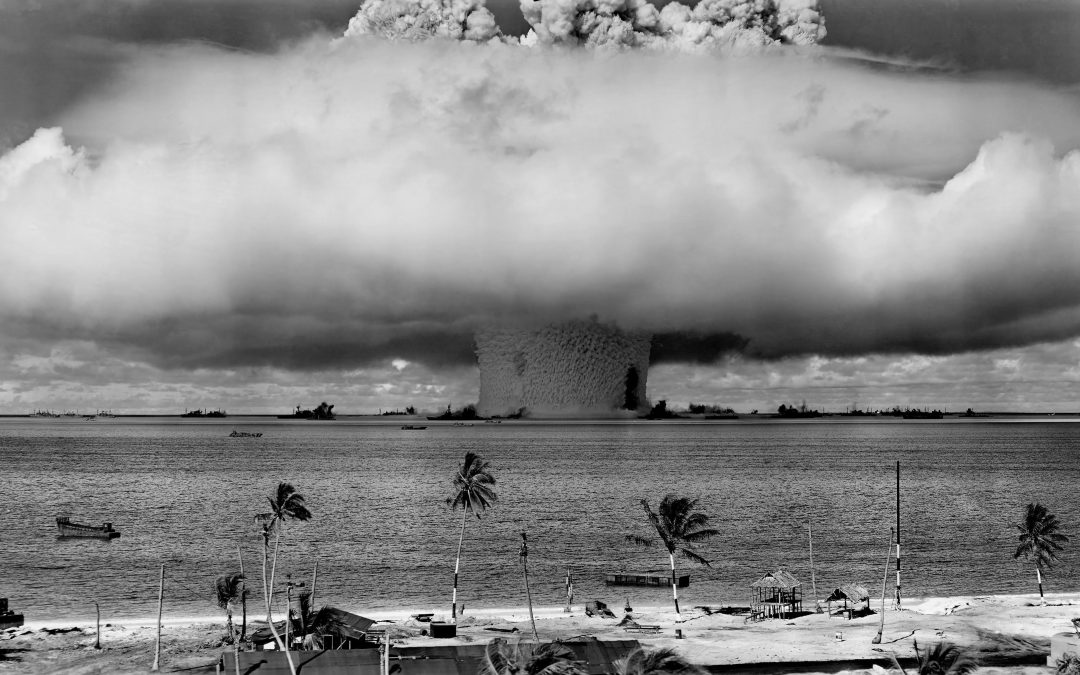For many, the word ‘nuclear’ conjures up grim ideas of radiation, mushroom clouds and war. Scientific developments have these sentiments changing rapidly to abundance, sustainability and peace.
Nuclear is more reliable than any other energy source. It is also among the safest and most environmentally friendly of them all. Despite this, the world is moving towards reactors at a maddeningly slow pace.
These are the concerns hampering public support for nuclear energy:
- The fear of nuclear power. The same reaction that is currently used to generate energy in a nuclear reactor can be used to make a nuclear bomb. The majority of the public does not separate feelings about nuclear energy from the devastation of the bomb.
- The possibility of a reactor meltdown. HBO’s wildly popular series, Chernobyl (2019), is just one way in which high-profile nuclear accidents have continued to weigh on the minds of the public. This is despite the thoroughly regulated safety standards that have been introduced following tragedies such as Chernobyl in 1986.
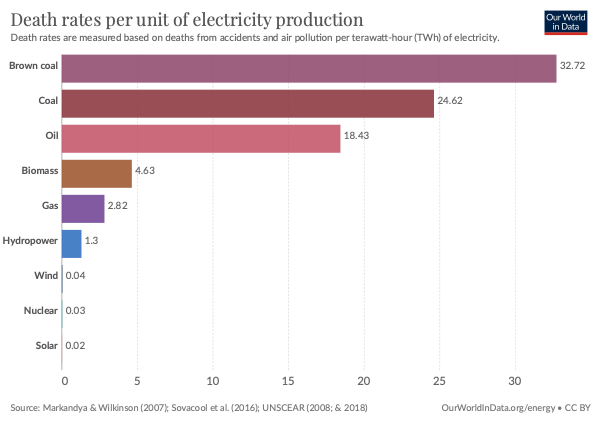
Nuclear energy is, in fact, second only to solar as the safest of all energy sources (factoring in Chernobyl, Fukushima and every other nuclear disaster).
• The issue of nuclear waste storage. Radioactive waste is generated when nuclear energy is produced in reactors. There is, at present, no ideal long-term solution for the safe disposal of this waste.
Enter nuclear fusion
A nuclear breakthrough has the world once again engaging in the clean energy debate. It may be the key to destigmatising nuclear energy and reaping its benefits.
In December 2022 a nuclear fusion reaction resulted in a net energy gain. Since the 1950s scientists have been trying to fuse atomic nuclei with a release of energy larger than the input energy requirement. This dream is now a reality.

What we know to be nuclear energy comes from nuclear fission, not fusion, process. Within nuclear reactors, a heavy nucleus is split to release energy. It is nuclear fission that releases radioactive particles and it is the nuclear fission process that can be used to make weapons.

Nuclear fusion delivers four times as much energy as nuclear fission and releases almost no radioactive particles. The fusion reaction also cannot be used to make nuclear weapons. It is the key to abundant clean energy.
Although this step is encouraging, the world is still far from being powered by a functioning fusion reactor. Until then, we have fission. What does nuclear energy, as it currently exists, have to offer? Are countries earnestly moving towards clean energy? And is it time to rethink the atom?
Comparing Energy Return On Investments (we are not in Texas in 1901)
Accessing oil today is not what it was one hundred and twenty years ago. We’ve all seen the cartoons: a man in a cowboy hat steps a little too firmly in a Texan canyon and is rewarded with a towering spout of black gold. Soon there are pipes, spades and drills, with every American scrambling to get their share. Until, of course, the evil oil company steps in. Suited businessmen wearing sunglasses lead in trucks mounted with drilling rigs. The cowboys and their tools are swept away by bulldozers. Big Oil is born.

The initial success of these companies seems obvious: they were better equipped to extract the oil. Using their tools and the benefits of their size, they could access more of the energy source at a lower cost. But these rigs have been drilling for more than one hundred years. Oil is non-renewable – a reserve can run out. When this happens, either new machinery is needed to go deeper or new reserves need to be found. Both options require more energy and a larger investment.

We can relate the amount of energy produced by a source to the energy it takes to harvest the source with Energy Return On Investment (EROI). EROI puts energy in real terms. It considers what we really care about when we compare oil to solar to nuclear. The fall of the cowboys to the suits and the suits to Mother Nature comes down to just this. The oil rig could extract oil with less effort – energy – per unit than a Texan with a spade could ever hope to do. However, fifty years after this nearly all discovered shallow reserves had been depleted. Seventy or so years after that? More input energy than ever is required to discover shallow reserves or extract from deep under the ground.
The Sustainability Research Institute of the University of Leeds calculated the EROIs of fossil fuels oil, coal and gas in their finished fuel stage. The results were a 23% decline in EROI over a period of 16 years. We are using up limited resources and it is taking increasingly more energy to access them.
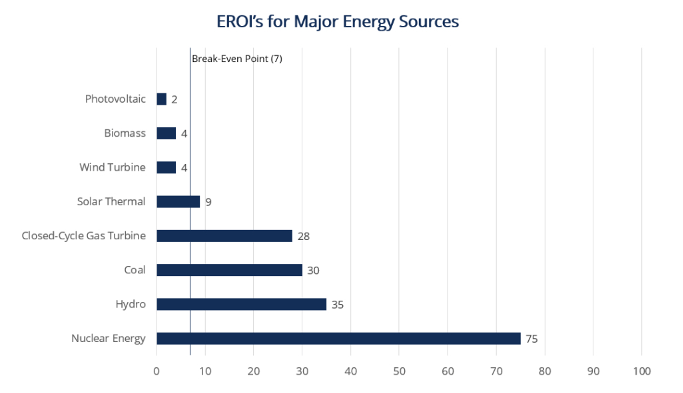
Almost every facet of modern society relies on energy generation. The decline in the EROIs of fossil fuels leaves renewable energy as the only viable way to maintain life as we know it. There is a clear winner among these green sources. In fact, among all major energy sources. This is nuclear energy, coming in hot with an EROI of 75.
How does nuclear energy compare to other green sources?
Not only does nuclear energy have a higher EROI than other renewable sources, it is also more reliable. For an energy source to be reliable means that it can provide energy in the exact quantity that is needed at the exact time it is needed. Picture this: a fierce blizzard hits the city. In every house, families are shutting their doors, grabbing their blankets, and turning on their internal heating. Why, then, do their houses remain cold? Because snow is falling on the municipality’s power source.

Hydro, solar and wind power need their sources to be guaranteed in order to be reliable. There is no guarantee when it comes to weather or water, especially in light of climate change. Evidence of this can be seen in the United Kingdom and Germany right now, where a so-called ‘wind drought’ is exposing the dangers of overconfidence in the turbines. This drought pulled the share of the UK’s electricity provided by wind down to 3.4% from its previous 28%.
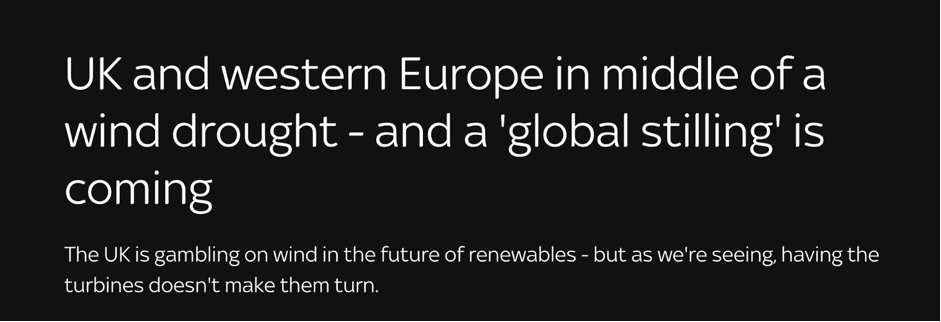
The reliability of energy sources are measured by capacity factors: how much energy a plant produces compared to the maximum amount it can produce. Wind and solar sources have low capacity factors. Bureaucrats prefer fossil fuels because they have higher capacity factors. This makes them more reliable sources of energy.
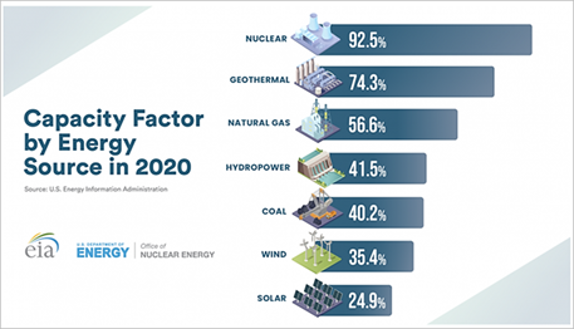
Fossil fuels are, however, not as reliable as nuclear energy. Nuclear energy has a capacity factor of 92.5%. This means that nuclear is not only the most reliable green source: it is the most reliable source of all.
How serious are countries about green energy?
Nuclear energy is clean, environmentally friendly, and reliable. But it is also expensive. Going nuclear means a steep initial capital cost. Solar and wind energy are the cheapest sources, but they are not reliable. This leaves fossil fuel options like coal: affordable, reliable but greenhouse gas machines.
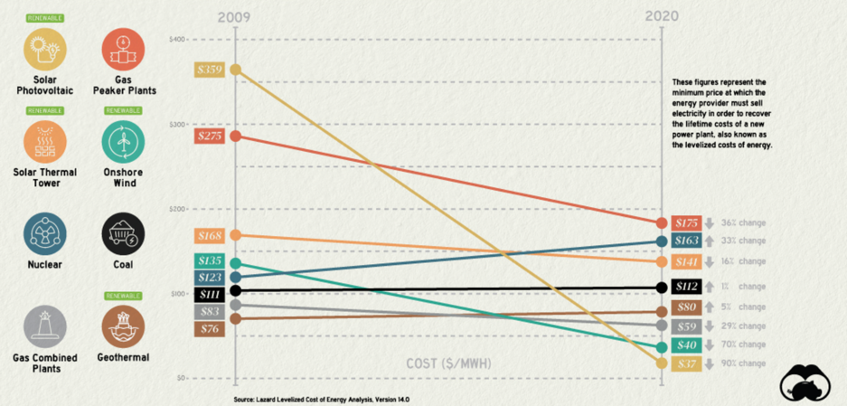
According to Climate Council (2022) there are some countries acquiring huge portions of their electricity from renewable sources: Scotland is at 97% and Costa Rica, Norway and Uruguay are at 98%. Yet two of the countries that can best afford turning to renewable sources – the United States and China – are considered the top two greenhouse gas emitters.
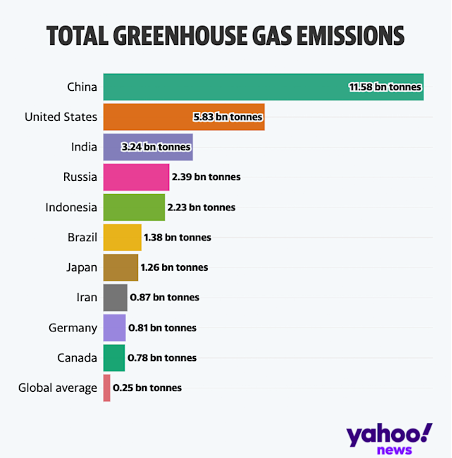
Despite its undesirable status as a leading polluter, the United States, alongside the United Kingdom and the European Union, are granting developing countries aid to transition to renewable energy. Yes, you read that right. They are asking countries with instability, humanitarian disasters and water sanitation problems to start using paper straws.
One year after $8.5 billion was granted to South Africa for this very purpose, the United Kingdom opened a brand new coal plant. An ancient, heavy duty polluter that could make you choke up coughing at the sight of it. This was done with less than 15 years to go before the country’s commitment to be free from fossil fuels.

If this knowledge makes your stomach churn, you can sleep a little more soundly knowing that the United Kingdom is in an energy crisis of their own. This problem is centred around gas – the fossil fuel that accounts for more than 50% of the country’s electricity supply.
The United Kingdom’s energy crisis and energy in Europe
When the world began to recover from the Covid-19 pandemic, the global demand for gas did too. Demand for gas has shot up and gas prices have followed. Despite relying heavily on gas, the United Kingdom has few capabilities for storing it. This makes it uniquely exposed to price fluctuations.
This, combined with an effective wind drought, seems to have left the United Kingdom desperate enough to relive the glorious, coal-powered Industrial Revolution.
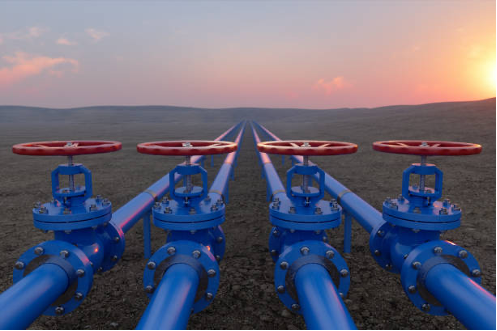
The gas price problem was made even worse for Europe when Russia invaded Ukraine. In recent years, Europe has become dependent on Russia as a provider of oil and gas. The economic sanctions and uncertainty of the war has left the continent’s energy supply vulnerable. According to BBC, since the onset of the war Russia has decreased its supplies of gas to Europe by 88%.
Embracing the atom
Relying on fossil fuel providers has given rise to an energy crisis in Europe. It should follow, then, that it is now an excellent time to turn to alternatives – alternatives like nuclear energy.
This is not what is happening. In the midst of the European energy crisis, Belgium has decommissioned a nuclear plant in perfect working condition. This is in response to a public anti-nuclear movement insisting nuclear power is unsafe. Except, of course, the numbers say it isn’t.
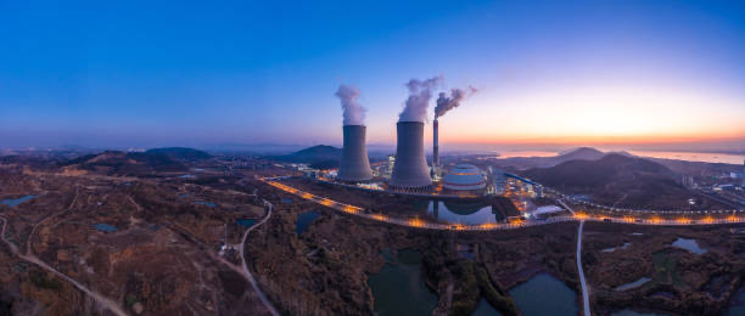
A nuclear reactor is expensive to build and maintain. In the wrong hands, the fission reaction can be deadly. Until we have fusion reactors, there is also the problem of the long-term disposal of radioactive waste. Is this enough to warrant the public rejection of reactors as an option?
Nuclear energy provides clean, safe and reliable energy. It may be time to rethink the way we view the atom.
